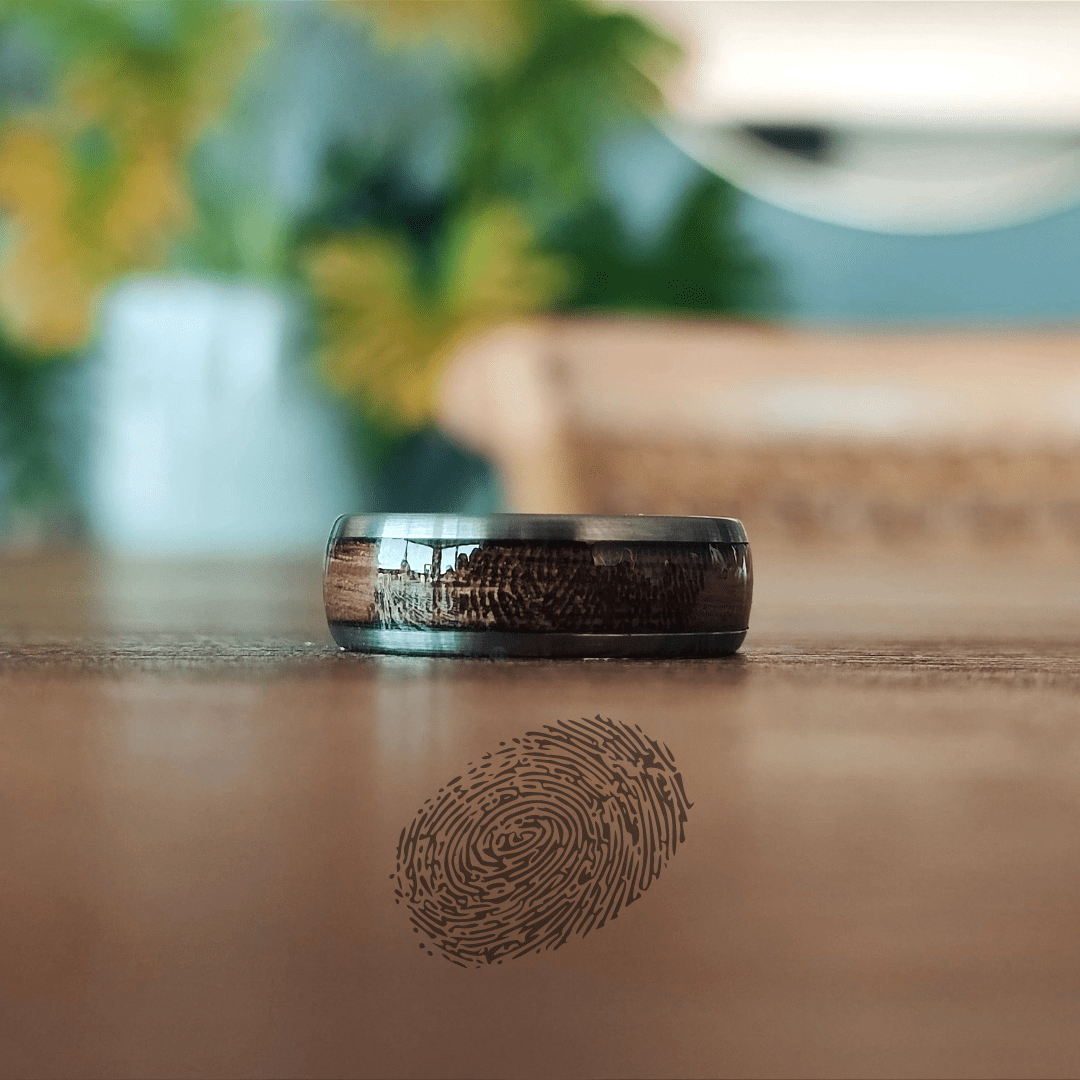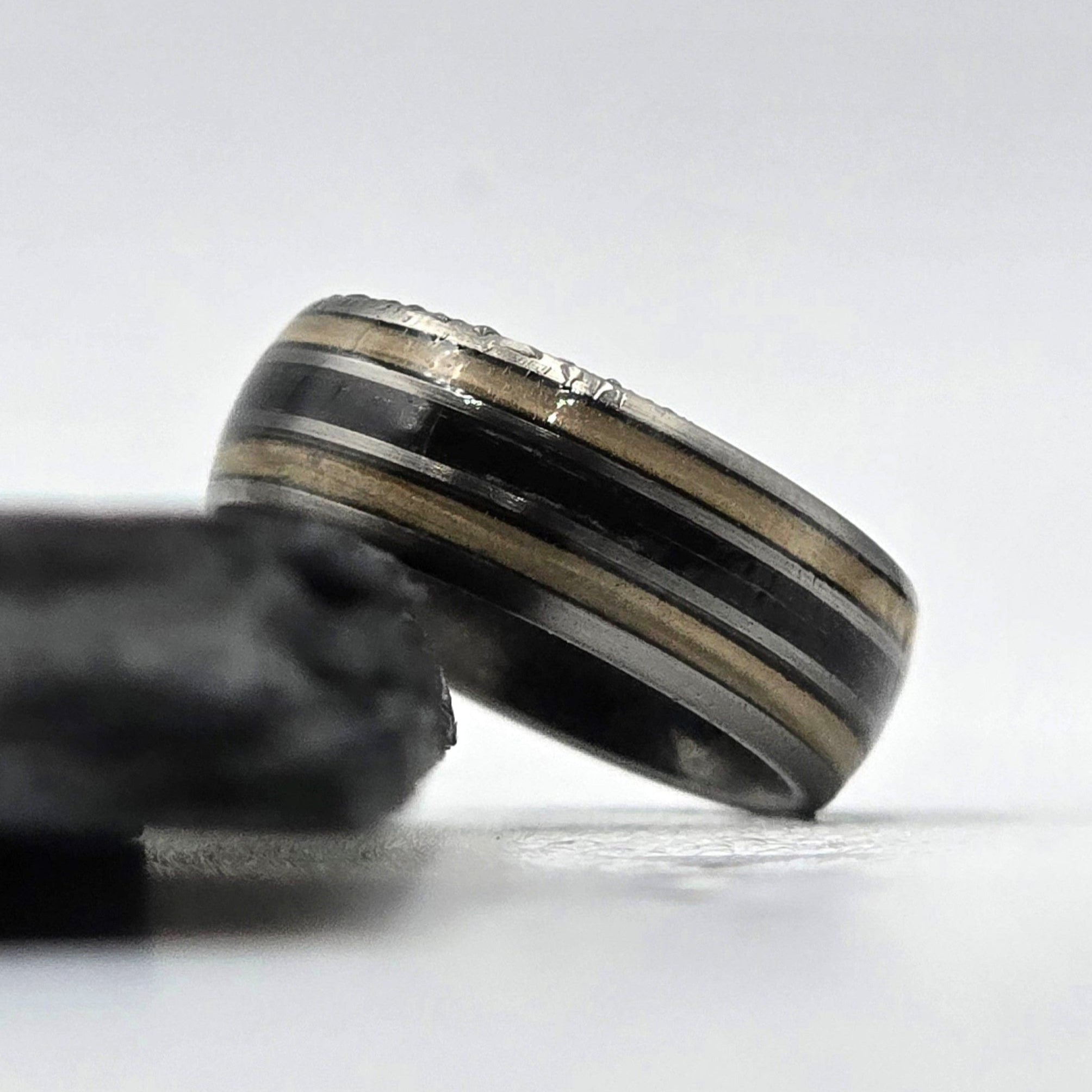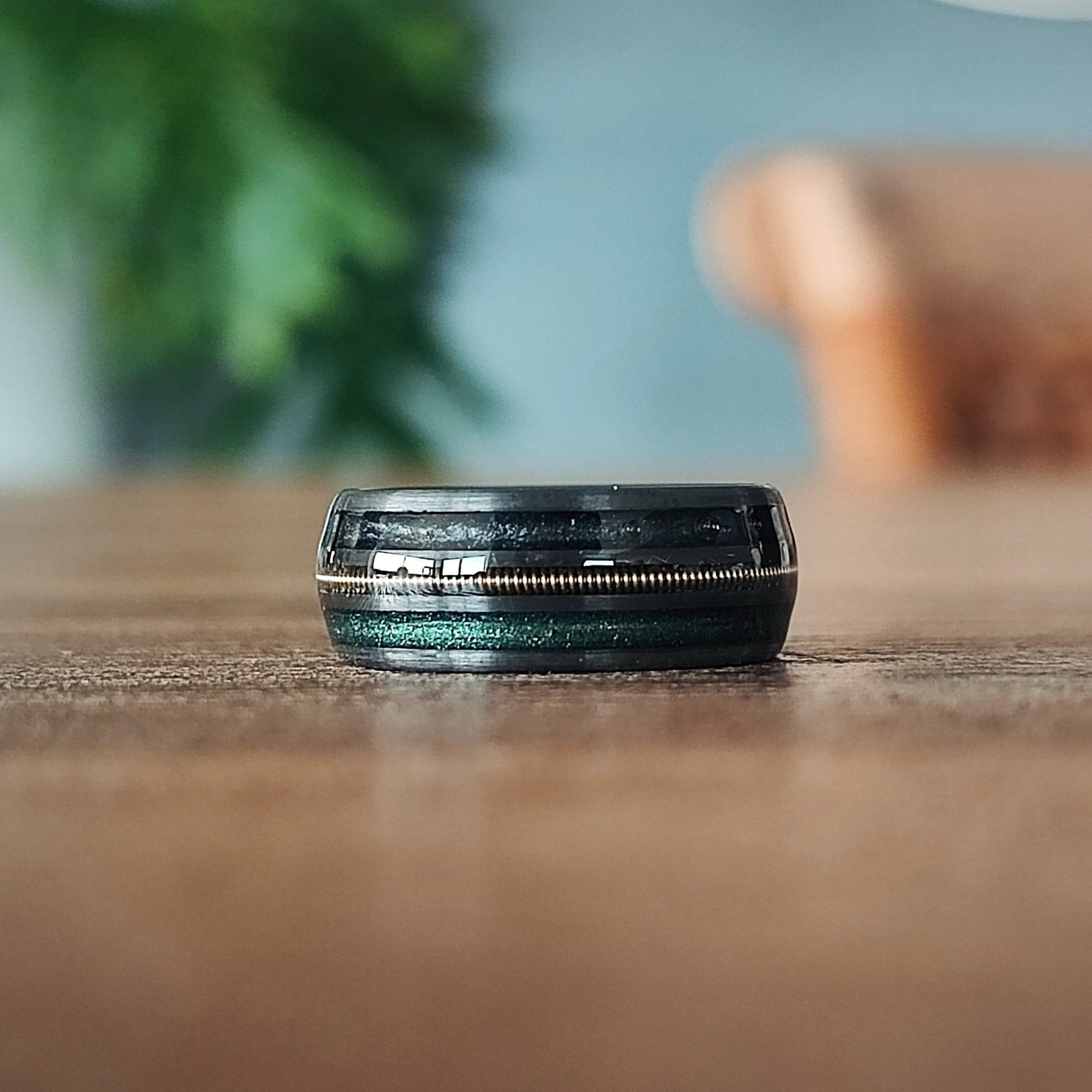
The Fingerprint Ring: Capturing Your Unique Identity in Ashwood and Tungsten
Introduction
Every fingerprint tells a story. It is a mark that no one else on earth shares, a unique signature of your identity that cannot be replicated. In a world where jewelry is often mass-produced, many people are searching for pieces that carry personal meaning. That’s where the Fingerprint Ring comes in—a stunning fusion of natural ashwood, sleek gunmetal tungsten, and your very own fingerprint. It’s not just a ring; it’s a permanent memory, crafted to symbolize love, remembrance, and individuality.
This blog explores everything you need to know about the Fingerprint Ring: from the symbolism behind fingerprints to the properties of tungsten and ashwood, the craftsmanship that goes into each piece, and practical advice on care, comfort, and ordering. By the end, you’ll know whether this one-of-a-kind design belongs in your collection—or on the hand of someone you love.
Why a Fingerprint Ring? The Emotional and Symbolic Value
Jewelry has always been more than decoration. It reflects milestones, identity, and personal history. But while initials or engraved messages are meaningful, a fingerprint captures individuality on a deeper level. It’s the only mark that is truly yours, never duplicated in the billions of people on earth.
The fingerprint ring transforms that biological uniqueness into a wearable keepsake. For couples, it can symbolize a bond that endures beyond words—a spouse’s fingerprint wrapped around your finger is the ultimate intimate gesture. Parents may choose to capture a child’s fingerprint, preserving the fleeting innocence of early years in a timeless form. Families also find comfort in memorial fingerprint rings, a way to carry a loved one’s touch forever. With the rise of custom rings online, it has never been easier to design and personalize these meaningful pieces from the comfort of home.
This move toward highly personalized jewelry reflects broader consumer trends. A 2023 Statista report highlighted that personalization is one of the top drivers of jewelry sales worldwide, with customers valuing story and meaning as much as craftsmanship. The fingerprint ring fits this cultural shift perfectly: it offers not just a design, but an extension of the wearer’s identity.
Materials Matter: Understanding Tungsten
At the core of this ring lies tungsten carbide, one of the toughest materials available for jewelry. Tungsten is a naturally occurring element, but when combined with carbon, it forms tungsten carbide—a compound prized for its exceptional hardness and durability.
Tungsten carbide ranks 8–9 on the Mohs hardness scale, just below diamonds, which makes it highly resistant to scratches. Everyday wear and tear from keys, coins, or tools barely leaves a mark, which is why tungsten wedding bands have soared in popularity over the last decade.
However, it’s not without drawbacks. Tungsten rings cannot be resized due to their rigidity, and while scratch-resistant, they are brittle under sharp impact. For example, dropping the ring on a hard tile floor or hitting it with enough force could cause it to crack. This is rare in daily use, but worth noting.
Compared with gold, silver, or titanium, tungsten provides a modern, industrial edge. Its natural gunmetal hue gives it a sleek, masculine aesthetic, while the brushed finish on this design softens the metallic sheen into something refined yet understated.
The Beauty and Strength of Ashwood Inlay
Complementing tungsten’s cool strength is the warmth of ashwood. Ashwood is a light-colored hardwood, traditionally prized for its strength, flexibility, and shock resistance. Furniture makers, tool handle manufacturers, and even baseball bat producers rely on it for these qualities.
Visually, ashwood has a subtle but striking grain, often creamy white with hints of light brown or gray streaks. Its open grain patterns add natural variation, ensuring no two rings look exactly the same. This aligns beautifully with the fingerprint concept: just as every fingerprint is unique, so too is each ashwood inlay.
From a practical perspective, ashwood is easy to work with and holds finishes well. In jewelry, it provides warmth against the skin, softening the metallic presence of tungsten with an organic touch. When sealed with protective resin, the wood maintains its luster while resisting water and wear.
The result is a balance between nature and modernity. Ashwood brings earthiness and tradition, tungsten brings resilience and contemporary design. Together, they make a compelling contrast that elevates the fingerprint ring beyond ordinary accessories.
Design & Craftsmanship: How the Fingerprint Ring is Made
Every fingerprint ring is born from meticulous craftsmanship. The process begins with capturing the fingerprint itself. Jewelers typically provide a simple ink kit or digital scan method, ensuring high resolution so the whorls and ridges remain clear. This image is then carefully engraved or branded into the ring’s ashwood inlay or tungsten surface, depending on the design.
The ashwood is cut and shaped to fit snugly into the tungsten band. Because tungsten is incredibly hard, precision tools are required to create the inlay groove. Once placed, the wood is bonded and sealed with resin, which not only enhances its durability but also preserves the fingerprint detail.
The ring’s exterior is then brushed to achieve a matte gunmetal finish. The comfort-fit dome shape is polished smooth on the inside, ensuring effortless wear. Before shipping, each ring undergoes quality checks to confirm the fingerprint is sharp, the inlay flush, and the epoxy finish seamless.
What makes this design remarkable is its balance between technology and artistry. It uses advanced engraving and sealing techniques but ultimately depends on the steady hands of skilled jewelers to transform your fingerprint into a lifelong keepsake.
Durability & Longevity: How It Stands Up Over Time
Durability is one of the greatest strengths of this design. Tungsten is often called the “forever metal” for its resistance to scratches and wear. Unlike softer metals such as gold, it maintains its look even after years of daily use. Many couples choose tungsten wedding rings precisely for this reason—they symbolize permanence in a physical sense as well as an emotional one.
Ashwood, on its own, would be less durable. Wood is vulnerable to moisture, rot, and insects. But with a protective resin coating, ashwood inlays become resistant to water and environmental stress. The epoxy used in these rings seals the grain and fingerprint engraving, ensuring the design remains intact even with daily exposure.
That said, owners should still take precautions. Extreme impacts, harsh chemicals, or prolonged water submersion could weaken the resin or stress the wood. With reasonable care, however, these rings can last for decades. Customers frequently report that even after years of wear, their fingerprint rings look nearly as fresh as the day they arrived.
Pros and Cons: Is This Ring Right for You?
Like any piece of jewelry, the fingerprint ring has advantages and potential drawbacks.
On the plus side, it’s undeniably unique. No other design better symbolizes individuality than your fingerprint etched into a ring. The combination of ashwood and tungsten gives it both warmth and resilience, while the protective resin makes it practical for daily wear. For those seeking a wedding band or keepsake with personal meaning, few alternatives compare.
On the downside, tungsten’s rigidity means the ring cannot be resized. If your finger size changes significantly, you’ll need a replacement rather than an adjustment. Ashwood, though sealed, is still an organic material and may require periodic care. Finally, customization adds time—expect an additional 3–7 working days beyond standard production.
This ring is best suited for those who prioritize symbolism and uniqueness over tradition. It appeals to couples, parents, or individuals commemorating milestones. If you work in environments where the ring might be subjected to heavy impact, you may need to exercise extra caution.
Fit & Comfort: Practical Considerations
While aesthetics often take center stage, comfort is just as critical in a ring meant for daily wear. The fingerprint ring features a comfort-fit design, where the interior surface is slightly rounded to reduce pressure on the finger. This makes it easier to slide over knuckles and more comfortable during long wear.
The dome shape of the exterior adds a subtle curve that feels smooth to the touch, while the 8mm width offers a bold look without overwhelming the hand. Men often favor this width for its strong presence, though it works equally well for women who prefer a statement band.
Because tungsten cannot be resized, accurate measurement is essential. Jewelers recommend measuring your finger at different times of day—fingers swell slightly in the evening and contract in the morning—to find the most reliable size. Consider seasonal changes as well; cold weather may shrink your fingers, while summer heat causes them to expand.
Overall, the fingerprint ring balances boldness with comfort, making it practical for everyday wear while still maintaining its symbolic value.
Water Resistance, Maintenance & Care Instructions
One of the most common questions buyers ask is whether the fingerprint ring is waterproof. Thanks to its epoxy resin coating, the answer is yes—within reason. The resin seals the wood and fingerprint engraving, protecting it from everyday splashes, handwashing, or rain exposure.
However, like any fine jewelry, it benefits from mindful care. Avoid soaking the ring in water for prolonged periods, such as during swimming or bathing. Chlorine and saltwater, in particular, can erode resin coatings and weaken the bond over time. Similarly, harsh chemicals like cleaning products should be kept away.
Cleaning is simple. Use a soft cloth and mild soap solution, gently wiping the surface. Avoid abrasive pads or strong solvents. When not wearing the ring, store it in a fabric-lined box or pouch to prevent accidental scratches or knocks.
Inspect your ring periodically for cracks in the resin or signs of wear on the wood. If needed, jewelers can re-coat the inlay, restoring both protection and shine. With this routine care, your fingerprint ring will remain as meaningful and beautiful decades from now as it is today.
Pricing, Lead Time & Ordering Process
The price of a fingerprint ring reflects both its premium materials and the customization involved. Tungsten, though less costly than gold or platinum, is more expensive than steel or titanium due to its weight and hardness. The ashwood inlay, fingerprint engraving, and epoxy coating add further craftsmanship costs.
Beyond price, timing is crucial. Because each ring is made to order, additional processing time is required. Standard lead times apply, but the fingerprint customization usually adds 3–7 working days. This is important to consider if you’re ordering the ring for a special occasion such as a wedding or anniversary.
The ordering process typically begins with submitting your fingerprint. Jewelers provide clear instructions—whether ink on paper or digital scan—to ensure precision. Once approved, production begins. Because of the personalized nature, exchange and return policies are usually limited, so selecting the correct size from the start is essential.
When the ring arrives, it comes ready to wear, polished, and sealed. The wait is worth it: you receive a piece that no one else in the world owns.
Real Stories & Examples: Customer Use Cases & Testimonials
Fingerprint rings resonate deeply with people, often marking life’s most significant moments. Couples frequently choose them as wedding bands, carrying a piece of each other every day. One customer shared that she loved seeing her husband’s fingerprint engraved in her ring, calling it “the most intimate reminder of our bond.”
Parents also use fingerprint rings as keepsakes. A father commissioned one with his daughter’s fingerprint before she left for college, a reminder of their unbreakable connection. Memorial designs are equally powerful—customers say they find comfort wearing a loved one’s fingerprint close, particularly when coping with loss.
Reviews often highlight not only the emotional value but also the craftsmanship. Many note that the resin coating holds up well even after years, and the comfort fit makes daily wear effortless. Others appreciate the compliments they receive, with friends intrigued by the story behind the ring.
These real-world experiences underline why the fingerprint ring is more than jewelry. It’s memory, identity, and art combined in one powerful piece.
Conclusion
The fingerprint ring in ashwood and tungsten is not just a piece of jewelry—it’s a deeply personal emblem of identity and connection. By fusing the industrial strength of tungsten with the organic warmth of ashwood and sealing it with your unique fingerprint, the ring captures permanence in both form and meaning.
While it requires careful sizing and a few extra days to produce, the trade-off is worth it. You receive a durable, waterproof, and one-of-a-kind piece that tells a story no other ring can. Whether chosen for a wedding, a gift, or in memory of a loved one, the fingerprint ring symbolizes individuality in its purest form.
For anyone searching for jewelry that goes beyond ornamentation, the fingerprint ring is a timeless investment—one that ensures your unique mark will never fade.



